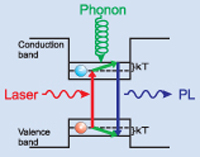
| Home | About Us | Contribute | Bookstore | Advertising | Subscribe for Free NOW! |
| News Archive | Features | Events | Recruitment | Directory |
| FREE subscription |
| Subscribe for free to receive each issue of Semiconductor Today magazine and weekly news brief. |
News
30 June 2008
Step towards laser cooling of semiconductors
German/French research suggests that laser light could be used to cool semiconductor structures. Scientists from Technische Universität Dortmund in Germany and CRHEA-CNRS (Centre de Recherche sur l'Hétéro-Epitaxie et ses Applications) in Valbonne, France have carried out an extensive study on ‘luminescence upconversion’ in gallium arsenide quantum well structures [Eshlaghi et al, Phys. Rev., vol.B77, p245317, 2008]. Luminescence upconversion is the process that is used to laser cool atomic vapors and condensed-matter systems such as dye solutions and glasses. In 1999, one group claimed to have achieved such cooling in a semiconductor system, but the interpretation of the results of that study has recently been questioned.
To perform luminescence upconversion, an exciting laser is detuned to an energy that is less than some resonant state. The energy difference is supplied from the thermal reservoir of vibrational energy (phonons) in the system. When the excited state decays as a photon it carries more energy away than was supplied by the laser beam, thus cooling the system. For net cooling, one has to ensure that this process dominates over alternatives where the energy of the photon is absorbed, eventually as heat (creating rather than destroying phonons).
The researchers used excitonic levels (schematically, electron-hole bound states) in single GaAs quantum well structures to probe luminescence upconversion at temperatures from that of liquid Helium up to room temperature. The barriers between the wells consisted of Ga0.35Al0.65As. The exciton binding energy can be varied through changing the thickness of the quantum well layer. Wells of various thicknesses (2.8-39.3nm) were stacked on top of each other in the sample so that emitted light would not be re-adsorbed by the wells above.

Graphic: Schematic of the phonon-assisted luminescence upconversion process in semiconductor quantum well.
When the photoluminescence resonance from an exciting laser is at a higher energy than the initial photon, the feature is also called an anti-Stokes line. A Stokes line is an emission resonance with less energy than that of the laser photons.
At very low temperatures the phonon population is very low and such upconversion is rare. But as the temperature increases the probability of upconversion should increase. It was found that the most efficient cooling occurred when the laser was detuned to an energy of about 2kT below that of the excitation (where k is Boltzmann’s constant relating temperatures and energies). This matched expectations from considering the expected phonon population.
The excitation levels shift down as the temperature increases, so that anti-Stokes lines eventually become Stokes lines. The experimenters also found efficient upconversion between excitons with the two types of hole – i.e. from heavy-hole excitons to the higher-energy light-hole exciton state.
The study only considered the laser absorption process, leaving aside possible loss mechanisms or parasitic absorption. Actual application of laser cooling to semiconductor structures would have to take these factors into account in the design. The paper suggests that it would be advantageous to have thick films consisting of a number of quantum wells to achieve such cooling. Improving the optical coupling efficiency through the use of anti-reflective layers or hemispheric couplers might also be necessary.
Dr Soheyla Eshlaghi (lead author of the paper) comments on the possibility of achieving net cooling: “There are some difficulties due to parasitic heating effects, which have to be overcome before net cooling of an entire system can be achieved. Nevertheless, we hope to be able to demonstrate this experimentally within the next 5 to 6 years.”
Search: GaAs GaAs quantum well
Visit: http://link.aps.org/abstract/PRB/v77/e245317
Visit: http://e3.physik.uni-dortmund.de/en
Visit: www.crhea.cnrs.fr
The author Mike Cooke is a freelance technology journalist who has worked in the semiconductor and advanced technology sectors since 1997.